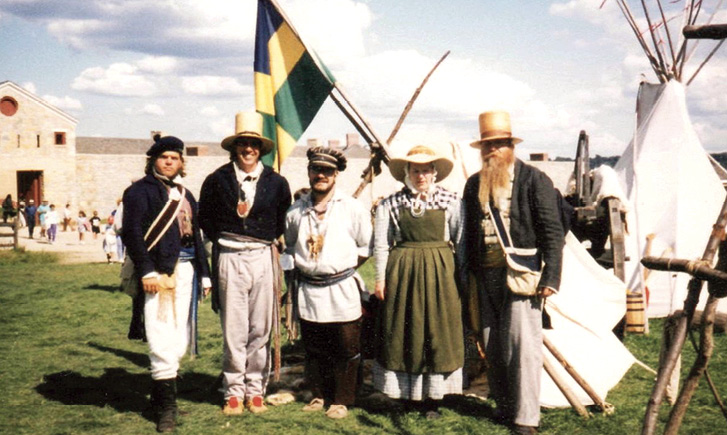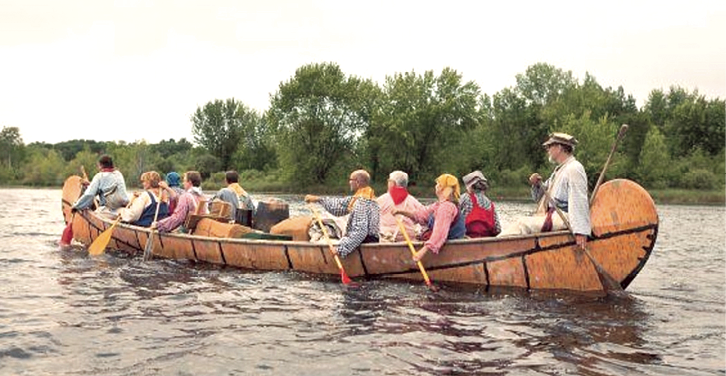It’s the late 18th century, and the North American fur trade is approaching its peak. Voyageurs are making trips back and forth along the Great Lakes and further west by canoe, transporting furs from the boreal forests back to Montreal. Fur trading companies are then shipping the pelts to Europe to supply the latest fashions.
The Hudson’s Bay Company has been actively trading European goods for furs in North America since the 1600s, while a newcomer—the North West Company, owned by Highland Scots—has gained a foothold since being founded in 1779. The North West Company uses its depot at Grand Portage, as the key meeting place for its wintering partners and its Montreal agents to conduct fur trades.
There is fierce competition going on between the two companies, to the point where they are close to a fur trade war.
Looking back on this history today, it’s easy to be fascinated. A commodity as basic as beaver pelts drove Europeans to a frenzy, and turned the Lake Superior region into a multinational trading hub. The big annual fur trading event, called Rendezvous, combined business with colorful celebrations, and could go on for weeks.
The romanticism of the fur trade lives on to this day thanks to people like Spencer Johnson, current president of La Compagnie des Hivernants de la Riviere Saint Pierre—a historical society based in Minnesota that conducts “living history” events on fur trade subjects. La Compagnie celebrates the voyageur lifestyle by re-enacting the voyageurs’ way of life through reproducing their dress, customs, and the foods they commonly ate.
The voyageurs were workers associated with licensed fur traders. They travelled extensively by canoe. The voyageurs faced many hardships as the “delivery drivers” of their day, travelling great distances using only human-powered means. They were the lowest caste in an industry that Johnson equates to today’s oil industry. “The fur trade was a huge global industry. There was a lot of money involved, and it went all over the world. There was power in these fur companies.”
Johnson explains that the North West Company outperformed the Hudson’s Bay Company right away upon establishment because they were “coming to the people,” rather than inviting the Indigenous people to transport their furs to far-away trading posts, as their Hudson’s Bay Company rivals did. The North West Company met the Indigenous on their own ground and worked closely with their Indigenous allies.
This influx of North West Company traders into the interior led to social changes in the societies of both the Indigenous trappers, and the European traders. In Johnson’s words, “It was very common for fur company traders and employees to marry into the local Indian tribes. Anytime you’ve got people mixing together, there’s going to be marriages.” The resulting mixed ancestry people were called Métis.
Johnson recounts that there were already three or four generations of mixed blood people in the Northern Wilds region by the time the North West Company and Hudson’s Bay Company eventually compromised on a merger in 1821. “The voyageurs would have French and Ojibwe, or French and Dakota, or French and Cree children. It was common for the fur companies to have employees who were bilingual or trilingual.”
The golden age of the fur trade came in the 1780s-90s. The North West Company established its trading post at Grand Portage in 1784, on land that today is the Grand Portage Indian Reservation.

A Grand Portage National Monument brochure details the significance of this fur trade post to voyageur customs: “A water network linked Montreal, capital city of the Great Lakes fur trade, with western Canada’s fur-bearing animals. Where streams were unnavigable, canoemen carried boats and cargo over a portage, or trail. Named Kitchi Onigaming by the Ojibwe and ‘The Great Carrying Place’ by French explorers and missionaries sometime after 1722, the Grand Portage bypassed rapids on the lower Pigeon River. It was the throughway to Canada’s prime fur country. To transport furs the company hired a backwoods navy of voyageurs.”
The original Grand Portage fur trading post, built where the 8.5-mile-long Grand Portage trail ends on the shore of Lake Superior, didn’t even last 20 years. The North West Company moved up the shore to present-day Thunder Bay, in 1803, and established a different trading post at Fort William.
Why the move? Johnson explains. “Nobody knew exactly where the boundary was between the U.S. and Canada. Some surveyors were sent out, and it turned out the North West Company’s trading post wasn’t in Canada. The surveyors figured out that the Pigeon River was the boundary, so now you’ve got a British post that’s 10 miles south of the border. They dismantled the whole thing and rebuilt it in present-day Winnipeg.”
The legacy of the fur trade is alive and well today. Minnesota middle schoolers learn about Minnesota fur trade history as part of their sixth-grade curriculum. Volunteers at historical museums like Fort Snelling, Snake River Fur Post, and Grand Portage, as well as Forts Folle Avoine in Wisconsin and Fort William Historical Park in Thunder Bay, provide us the opportunity to look back in time through historical interpretation of the fur trade period. These outdoor museums teach school children and families about the fur trade era in living colors.
So just how daring and hard-working were the voyageurs, whose reputation suggests almost superhuman physical powers? While critical thinking would suggest that many voyageur tales are embellished, Patrick Shifferdecker, site manager of the Minnesota Historical Society’s Snake River Fur Post open-air museum in Pine City, Minn., suggests some of their exploits were real. “There was an express canoe that left Montreal and went out to Fort William, or vice versa, a distance of about 1,400 miles, and they covered the route in 12 days. That was a select group of paddlers carrying nothing other than provisions. More typically, this route would take the voyageurs four to six weeks.”
This summer is a great chance to experience voyageurs culture for yourself. Fort William Historical Park is celebrating its 50th anniversary as an open-air museum. There, passionate historical interpreters recreate the times of the voyageurs.
Shifferdecker and Johnson find joy and pleasure from reproducing fur trade culture, down to the smallest details. For Johnson, “Re-enactors want to get it right. They take it seriously. They dress up accurately. It’s fun to do that, and do it well. I think we’re giving the voyageur period its due credit today. It’s a big piece of our culture here.”
You can learn more about the voyageurs at reconstructed fur trade posts throughout the Northern Wilds region.




